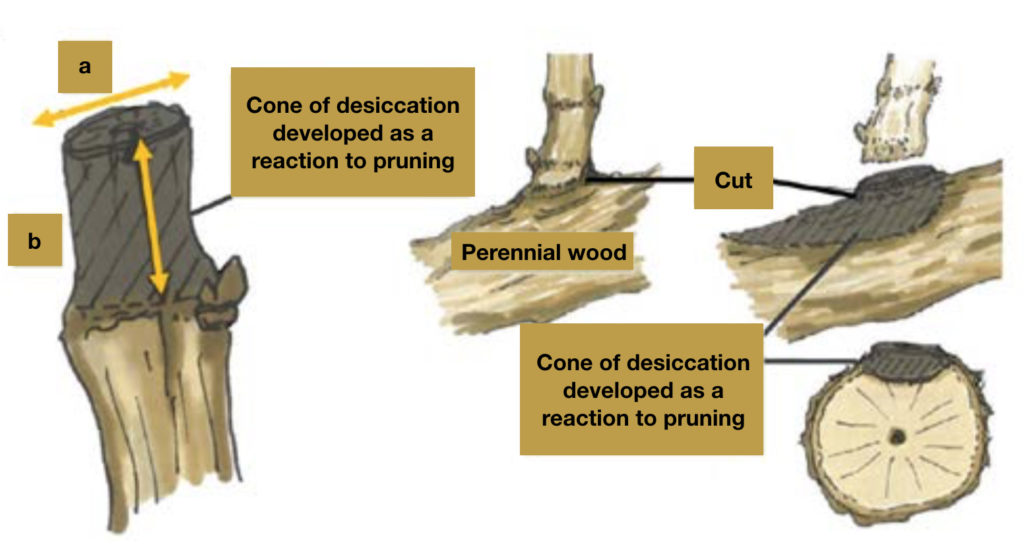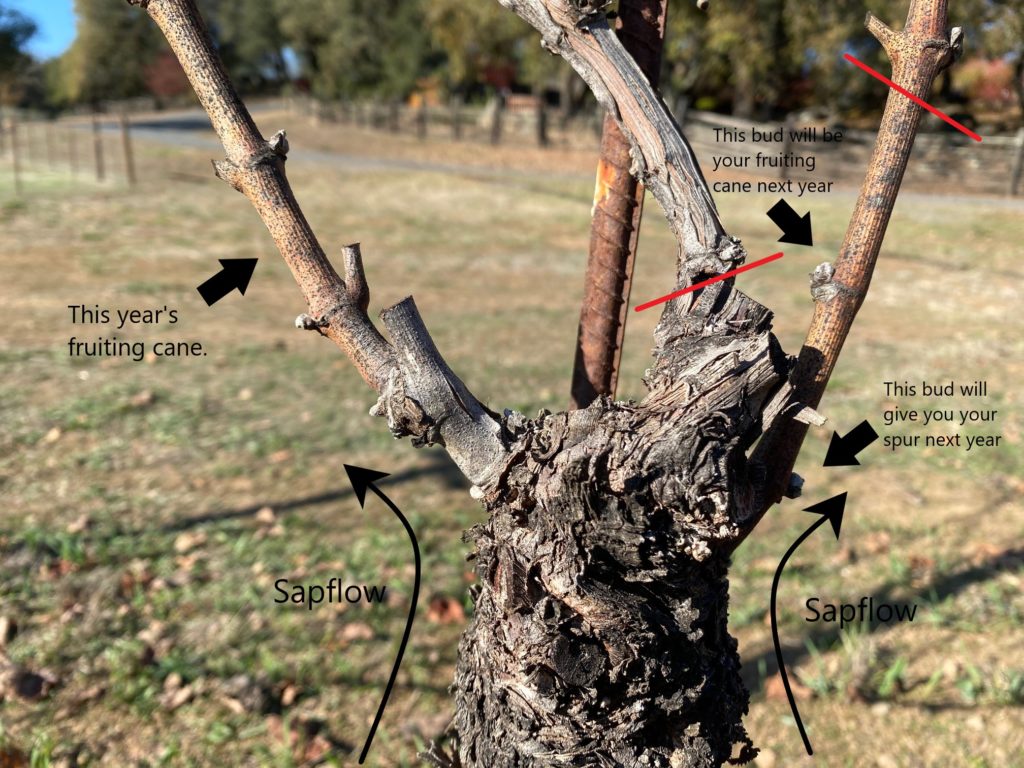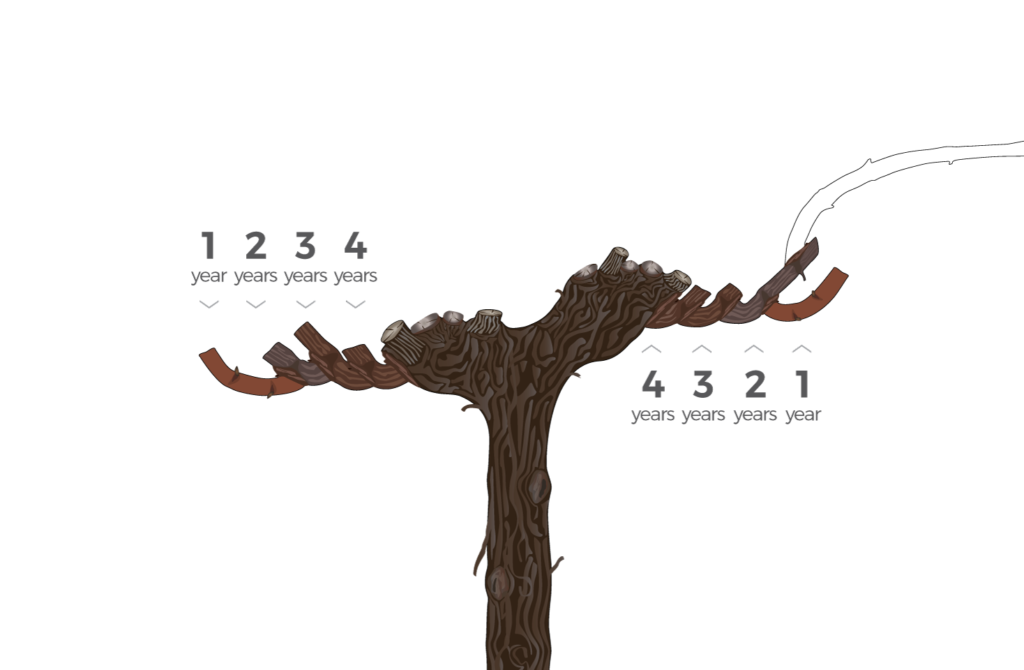What is sap flow pruning?
Some basic principles should be applied to pruning to sustain vine health over the long-term
The following is an excerpt from “Grapevine pruning to maintain sap flow“, which originally appeared in Wine Business Monthly in February 2021.
I was first trained in the art of sap-flow pruning while working in the vineyards of Piedmont, Italy as plucky young wannabe viticulturist. Piedmont is a long car ride from Friuli, the homeland of this whimsical method. Nevertheless, both regions have a similar history in terms of grapevine cultivation and while I believe most elements of this pruning method are widely applicable, it’s important to understand where the concept came from so as to adequately discern which elements fit best into your viticultural stylings.
Over the last century, Italian viticulture went from a “something grandpa did in the garden” to a real industry. While some grandpas were attentive and observant in the vineyard, the efficiency of pruning with a chainsaw was a big draw, especially since the average Italian farmer is overworked and most vineyard operations are understaffed. Simpler, albeit destructive, methods persisted with the influx of foreign labor, often from places with little viticultural background. The result was that 50+ year old vineyards were getting hacked apart, trunk disease was steadily rising, and vineyards didn’t seem to be lasting come una volta (like they used to).

Enter Simonit and Sirch, the Pendelton-clad hipster pruners with perfectly coiffed hair here to make pruning cool again. Now everyone’s jumping on the bandwagon, which is good. Pruning is pretty chill, especially when your steel-toes are buried in three feet of snow.
Even if you don’t have a century-old vineyard you’re looking to bring back from the brink, pruning sets you up for success or failure long term. The following is a breakdown of the basic concepts of sap-flow pruning. Hopefully it will better show how you can apply it in your own vineyards, regardless of where you are.
Basic Concepts:
Keep both sides working

A lot of what you see in old Italian vineyards is a giant trunk with only a small portion of it alive and growing. The rest is dried up and dead. In grapevines, if you don’t use it, you lose it. Vegetative tissue is what draws sap up, passing through the lower wood and keeping it alive. The best way to keep using it, is to leave either a fruiting cane or a renewal spur on both sides of the trunk (180 degrees apart from each other along the trellis wire is the most logical).
According to Simonit, the most important thing is the position of the renewal spur, seeing as that is what persists with time. Since on a single guyot (cane on one side and spur on the other side), you’ve only got one side working in a given season, that spur and the shoots arising from it is the only thing keeping the sap moving up the side you’re not using. Most of what I see in California is double guyot (two canes on opposite sides of the head) so if you want to forgo leaving a renewal spur, as we’ve chosen to do in many of the vineyards we manage, you just need to make sure your fruiting canes are positioned opposite each other, as opposed to each stemming from the same portion of the trunk.
Work under your cuts
Sap-flow pruning is largely based on avoiding making large cuts to old wood (older than two years). First of all, large cuts allow for the invasion of trunk-disease-causing pathogens. Equally important though is the development of necrotic tissue that develops after a cut is made. This cone of dead tissue extends into the trunk of the vine and interferes with the sap-flow. If you leave a fruiting cane or worse yet, your renewal spur, in the middle of a bunch of large cuts on top of the vine head, you’re essentially restricting any sap flow to a trickle by the increased resistance to flow. Long term productivity is going to suffer. Your best bet is to work with renewal spurs and canes that are growing out from below the head.

Leave space when you make a cut
Pruning requires cutting and sometimes you need to make cuts to wood that’s older than two years old, especially when you’re setting your vines up for sap-flow pruning. When you do this, it’s important to leave a portion of wood that will absorb the necrotic scar tissue that will form below the cut. The larger the diameter of the cut you make, the deeper that necrotic tissue is going to travel into the trunk. The general rule of thumb is to leave a portion of wood that is twice the diameter of the cut you made. A lot of pruners like to leave the vine looking nice and shaved down and find the practice of leaving a stub to look untidy. I found a lot of old-timer Italians had a hard time getting over it but get over it you must. The following year, as long as the portion of wood didn’t contain any residual buds that produced shoots, that extra neck of wood will be dry and you can slice it off completely with no damage to the underlying tissue.

It’s also suggested to leave a portion of wood at the end of your fruiting cane, cutting immediately below the first bud you’re discarding. If you live in an area with cold springs, this can ensure your final bud is protected (although precautions against winter kill are still recommended if you’re located in a place with very cold winters). If anything, I’ve found this makes tying down canes easier.
Respect the crown
This brings us to the next point: never blind a bud unless you’re expecting to completely eliminate that wood next year. At the base of every cane, there is what’s known as the “crown”. Grapevines have compound buds consisting of primary, secondary, and tertiary bud inside each “bud”. Usually, the primary is what develops into your green shoot/woody cane. If the secondary and tertiary didn’t sprout and give you a “double” or “triple” to whack off during suckering, they’re still hanging out and can go off years after the original cane was chopped.
A lot of pruners like to shave off what they consider unusable canes, eliminating them down to nothing. (Refer to images below). This does make suckering easier in the spring, but if you’re thinking long term, you never know when you’re going to want to return to the trunk and when that happens, you’re going to want that crown intact. Even if your vine is well set up with two growing points opposite each other, eventually you may find yourself too far down the trellis wire and you’ll want to renew everything right back to the trunk. If the vine has been continually given a buzz cut over the last decade, there won’t be anything to work with. (It’s worth noting that the crown is not the same thing as the basal bud, which is the first free bud on a cane or spur. When removing a cane, the basal bud needs to go too.)


Orient your buds
This is where the true artistry of sap-flow pruning comes into play. If you slice open a vine across its width (radially), the vascular tissue is in the form of a ring around the perimeter of the trunk. This means that external/outward facing tissue is more directly fed by the flow of sap than anything facing back towards the head. Ideally, you want the sap to flow directly to your green tissue, unobstructed by cuts of any kind. If you’re using two bud renewal spurs, the first bud from the trunk should be facing outward. This will give you your spur next year. The top bud should be facing upward and will be your fruiting cane (one of two options if you’ve left two spurs). This way, next year you will eliminate your old fruiting cane and be left with a lower, unobstructed spur that has direct access to sap-flow (Refer to image below). The easiest way to check the orientation of your buds is to run your hand from the bottom of the trunk up. The first bud you touch should be you spur the following year. In the long run, this will create a vine that resembles a goblet, with cuts only being made to the top and renewals moving outward from below.

If you’re not leaving renewal spurs and instead only leaving a couple of fruiting canes, then each fruiting cane should come from the external facing buds since that is where you’ll be drawing canes in future years.
I believe there’s some leeway with this point. Some varieties grow upright on their own. Others are content to grow downward. Don’t leave a spur that’s facing downwards, or a fruiting cane that’s going to be impossible to bend. In the end, if you’re making small cuts and leaving space below each cut to absorb the necrotic tissue, the vine isn’t going to have to work that hard to push sap to new tissue. Don’t bend over backwards trying to make your vine into the perfect shape if it’s going to be a pain in the ass to farm.


Most importantly, trust your observations and your common sense
A lot of pruning is still common sense. Don’t leave weak canes, even if they are positioned perfectly. Weak perpetuates weak so start with something strong – cane/spur diameters of 3/8” or more is a good guideline. If you find yourself in the middle of bunch of big cuts, leave a short renewal spur lower on the trunk and see what comes out of the basal buds next year. Even a budless spur lets your suckering crew know that you’re waiting for something to come out of the crown there.
Simonit and Sirch are from Friuli, and while that region has a smattering of international varieties it’s famous for its Friulano, Schioppettino, and Ribolla Gialla. Heard of any of those? You should. They’re tasty, but that’s another story for another soapbox. I learned how to sap-flow prune on Nebbiolo, a variety known for its low bud fertility. When we followed all the rules to a T, we ended up with a pretty lean year. Nebbiolo also has internodes that go on for days, and leaving two bud renewal spurs ended up being a foot long in some vineyards. In the vineyards we work on here on the Sonoma Coast, renewal spurs in addition to two fruiting canes have proven to provide too many growing points and vigor has suffered. Having four extra shoots to contend with also makes the canopy messy and more susceptible to fungal diseases. We scrapped the spurs. No big deal. You are, in the end, the farmer. Pay attention and react accordingly.
Photo Citations
Simonit&Sirch. 2021. simonitesirch pruning method. [online] Available at: <https://simonitesirch.com/simonitesirch-pruning-method/> [Accessed 3 March 2021].
Wineaustralia.com. 2021. Soft pruning making a big impression – at last. [online] Available at: <https://www.wineaustralia.com/news/articles/soft-pruning-making-a-big-impression-at-last> [Accessed 3 March 2021].
Winetwork-data.eu. 2021. [online] Available at: <http://www.winetwork-data.eu/intranet/libretti/0/libretto16497-01-1.pdf> [Accessed 3 March 2021].



great explanation, thanks heaps